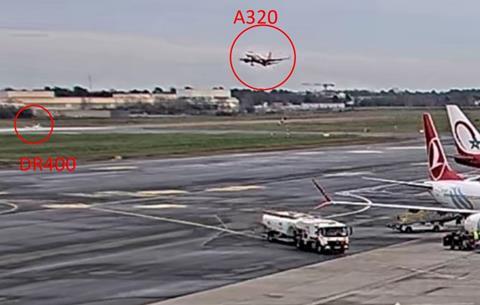French investigators have determined that a tower controller forgot that a light aircraft was awaiting take-off at Bordeaux before clearing an EasyJet Airbus A320 to land on the occupied runway.
The light aircraft, a Robin DR400 with two people on board, had been instructed to line up and hold at the threshold of runway 23, to avoid wake turbulence from a preceding Air France A321 departure.
At the time of the line-up, the inbound EasyJet aircraft was established on approach some 8nm from the runway at a height of 2,800ft.
French investigation authority BEA says the controller then became pre-occupied, for about 2min, with several air traffic movements.
These included the climbing Air France A321, two visual-rules flights passing through the control zone, and a third, heading for Courchevel, which was requesting flightplan activation.
The controller interrupted communications with these flights to authorise the A320 crew to land, as it descended through 766ft about 1.7nm from the threshold.
BEA says the DR400 pilot, aware that he had been waiting over 3min for wake avoidance, and understanding that the A320 was cleared to land, contacted the tower and informed the controller of his presence on the runway.

The controller immediately ordered the A320 crew to execute a go-around. Analysis shows the A320 descended to 103ft – about 290m (350ft) before the threshold – before climbing away, passing over the DR400 at 178ft.
BEA says the A320 crew was focused on a different point of the runway and did not see the waiting aircraft. The jet (OE-INE), with 185 occupants, subsequently landed without further incident.
The inquiry into the occurrence, on 31 December last year, states that the interval between line-up and take-off clearance should not exceed 90s, in order to avoid the situation in which a waiting aircraft is forgotten.
BEA found that a duty roster had provided for the presence of six controllers but, under a prior agreement, the number was reduced to three at the time of the event.
This resulted in the grouping of controller positions which were dissimilar in nature. BEA says controllers’ attention had to be distributed alternately between the runway and radar display screens.
BEA says there is a generalised practice – which is “tolerated” for the sake of “social peace” – of adjusting the number of controllers on shift, leaving the French air navigation service without “reliable” knowledge of occupied controller positions.
It is recommending that the French air navigation service equips control centres with means to record the presence of controllers at their positions, to ensure adequacy of staffing and enable analysis of safety occurrences.


























